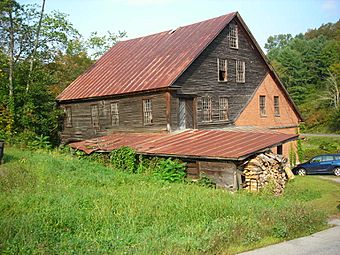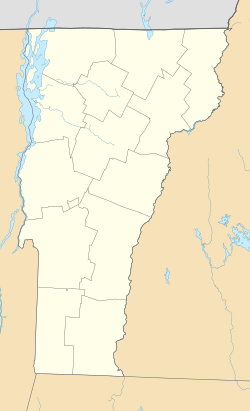Hayward and Kibby Mill facts for kids
|
Hayward and Kibby Mill
|
|
|
U.S. Historic district
Contributing property |
|

The mill building
|
|
| Location | Spring Rd. at First Branch White River, Tunbridge, Vermont |
|---|---|
| Area | 1.3 acres (0.53 ha) |
| Built | 1820 |
| Built by | Adams, A.C. |
| Architectural style | Grist & saw mill |
| Part of | Tunbridge Village Historic District (ID94000635) |
| NRHP reference No. | 92000094 |
Quick facts for kids Significant dates |
|
| Added to NRHP | March 12, 1992 |
| Designated CP | June 24, 1994 |
The Hayward and Kibby Mill, also known as the Tunbridge Mill, is a very old industrial building in Tunbridge, Vermont. It's a special place because it still has its original water-powered machines from the 1800s. The main part, a grist mill, was built around 1820. A sawmill was added later, around 1870.
This mill is one of the few water-powered mills left in Vermont. It might even be the only one that has both a sawmill and a grist mill working together. Because of its history, it was added to the National Register of Historic Places in 1992.
Contents
What is the Tunbridge Mill?
The Hayward and Kibby Mill is located north of Tunbridge village. It sits on about 1.3 acres of land. This area is right next to the First Branch of the White River. The mill complex includes several parts. There's the main mill building and a special canal that brings water to it. You can also see a former blacksmith shop and the Mill Covered Bridge. This bridge crosses the river near the mill.
How the Mill Building is Designed
The main mill building has two parts. The oldest part is a brick structure built around 1820. This was the grist mill, used for grinding grain. Around 1870, a larger wooden sawmill was added. This part was used for cutting logs into lumber.
Across Spring Street from the mill, there's another old brick building. It was built around 1803 as a blacksmith's shop. Today, it has been changed into a home.
How the Mill Gets Power
The mill uses water power from the river. A stone-lined canal carries water from a dam to the mill. The original dam was washed away by a flood in 1927. A new concrete dam was built in 1928. Inside the mill, you can still see and use the old 19th-century machines. They are powered by a turbine that was put in during the early 1900s.
History of the Tunbridge Mill Site
People have been using this spot for industrial work since the 1780s. It was a great location because the river naturally narrowed here. This created a strong flow of water, perfect for powering mills.
The very first mill on this site was built by Elias Curtis. He also shared his water rights with Samuel Bement. Mr. Bement then built the blacksmith shop.
When Was the Brick Gristmill Built?
It's not completely clear exactly when the brick gristmill was built. It looks like it fits the style of buildings from around 1820. However, it might have been built in the 1830s. At that time, other buildings in the village were made using bricks from a nearby brickyard.
The Mill Covered Bridge
The famous covered bridge near the mill was built in the 1880s. This bridge is also very important historically. It was listed on the National Register of Historic Places by itself in 1974.



